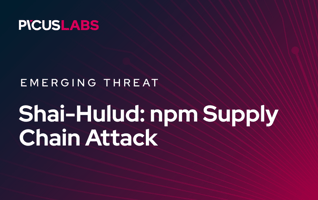Picus Exposure Score (PXS) Explained
Security teams are drowning in vulnerability data. Each year, 40,000+ CVEs emerge, and traditional scores label 61% as critical. But the reality is, only a small subset of these vulnerabilities pose a real risk to an organization. Traditional scoring systems like CVSS quantify theoretical severity, EPSS estimates short-term exploitation likelihood, and asset value prioritizes business relevance. But none of these tell you the one thing that matters most:
Is this vulnerability actually exploitable in your environment?

Figure 1. Deprioritizing Theoretical Vulnerabilities, Focusing on Gaps that Matters
To answer that, Picus Security has introduced the Picus Exposure Score (PXS). This is a new metric that factors in how your existing security controls perform against real-world attacks.
Unlike traditional risk scores based on assumptions and predictions, PXS is grounded in validation and evidence. It tells you not just what could be dangerous, but what is dangerous to you, right now.
The Problem with CVSS, EPSS, and Asset-Only Prioritization
The cybersecurity industry has long relied on scoring systems like CVSS, EPSS, and asset tagging to determine vulnerability criticality. Each plays a distinct role.
-
CVSS, for instance, provides a severity score based on technical details like attack vector and impact.
-
EPSS, developed by FIRST, brings a probabilistic approach to predict whether a CVE is likely to be exploited in the next 30 days.
-
Asset tagging, on the other hand, is used internally to help correlate vulnerabilities with business-critical systems.
However, these systems share a fundamental limitation. None of them take into account whether the vulnerability is actually exploitable given the security controls and architecture in place.
|
A CVE may have a score of 10, but if your layered defenses detect and block every attempt to exploit it, does it really warrant urgent remediation? |
Without a control-aware layer, traditional scoring creates noise.
Security teams chase down CVEs that pose no real threat while potentially overlooking risks that fly under the radar. This gap between theoretical risk and validated exposure is what the Picus Exposure Score is designed to solve.
What Is the Picus Exposure Score (PXS)?
The Picus Exposure Score (PXS) is a metric designed to reflect the actual exploitability of a vulnerability in a specific environment. It does this by combining attack simulation data, threat intelligence, and security control effectiveness into a single, evidence-backed score.
-
CVSS presents vulnerability's impact on the vulnerable asset in isolation.
-
EPSS presents whether the vulnerability is exploited in the wild
-
PXS shows whether your vulnerable assets are actually exploitable.
PXS is both dynamic and contextual. It combines static vulnerability data with real attack attempts simulated using Picus’ Adversarial Exposure Validation technologies, including Breach and Attack Simulation (BAS) and Automated Penetration Testing. These simulations mimic how vulnerabilities are exploited in real-world malware and threat actor campaigns, enabling the Picus Platform to measure how well your existing controls defend against actual threats.
In short, Picus Exposure Score provides a continuous view of your environment's exposure posture. When used in conjunction with other scoring models, it enables a more comprehensive, layered approach to prioritization and remediation.
How PXS Works: The Role of Security Control Effectiveness
PXS is derived through a multi-phase process that begins with threat contextualization.
For a given vulnerability, Picus maps all relevant exploit techniques using its threat library. These techniques are then simulated against an organization's environment, either through deployed agents or extrapolated data.
During this simulation, control telemetry is collected to assess whether security tools (like EDRs, firewalls, or SIEMs) blocked, logged, or alerted on the attack. This results in a Security Control Effectiveness (SCE) score that directly feeds into the PXS calculation.
The final PXS is then computed by integrating:
-
Security Control Effectiveness (SCE)
-
CVSS base and environmental metrics
-
EPSS scores for predictive insight
-
Asset criticality based on business context
Importantly, each PXS value is traceable and auditable, with underlying evidence from simulated threats and system responses.
From Agents to Extrapolation: Scaling PXS Across the Enterprise
While agent-based validation delivers the most precise results, large-scale deployment across every endpoint is often unrealistic.
|
To solve this, Picus developed the Extrapolation Engine, a supervised machine learning model that predicts how an asset will respond to attacks based on existing simulation data and its control configurations. |
The Extrapolation Engine leverages billions of historical simulation outcomes from Picus' cloud. As a result, even devices that don’t have agents installed can receive PXS scores with a high degree of confidence.
This approach provides scalable validation across cloud, on-premise, and hybrid environments, including hard-to-reach segments such as IoT devices or legacy systems. It ensures that organizations can move from point-in-time control testing to continuous exposure scoring.
Real-World Example: Reassessing Log4Shell with PXS
Let’s consider a scenario where Log4Shell is detected on three different assets within an organization:
-
A cloud-hosted HR management system
-
An internal intranet application
-
A credit application in the DMZ
CVSS assigns each a score of 10.0. EPSS marks the vulnerability as highly likely to be exploited. Asset value labels them all as critical. Based on these inputs alone, the security team would be compelled to patch all three immediately.
But PXS tells a different story. Once attack simulations are run, the findings are as follows:
-
The HR system lacks compensating controls. PXS remains at 9.1.
-
The intranet app detects the attack but doesn’t block it. PXS is calculated as 7.3.
-
The credit app blocks and logs all exploit attempts. PXS drops to 5.2.
This level of granularity allows teams to prioritize remediation based on evidence.
Urgency is applied where necessary, while secure assets are assigned a longer SLA, reducing disruption and burn-out.
Shrinking the Backlog: The Operational Value of PXS
The impact of PXS is perhaps best illustrated through numbers.
In one case study involving a mid-sized financial organization, the implementation of PXS and Exposure Validation led to a 97% reduction in urgent patching workload.
|
The organization began with a backlog of 15,000 open issues across 10,000 assets.
CVSS identified over 9,000 as high or critical. After layering in EPSS and asset value, the number was reduced to around 6,700.
But only after running adversarial simulations and applying Picus Exposure Score (PXS) did the high-priority list shrink to 1,300.
Following PXS-driven hardening efforts, such as deploying vendor-specific signatures, improving detection rules, or adjusting firewall policies, the critical list was reduced further to just 300 items.
Moreover, the team discovered that 2% of vulnerabilities previously considered “medium” were in fact exploitable and required urgent attention. |
This example underscores the double benefit of PXS: it reduces noise and highlights hidden risks.
Evidence-Driven Justification for Every Stakeholder
One of PXS’s greatest strengths lies in its traceability. Every score is backed by concrete evidence: what threats were simulated, which controls were tested, what responses were recorded.
This makes it easier to justify deprioritization to internal teams, regulators, auditors, and insurers. Instead of relying on theoretical threat models or vendor claims, security leaders can point to actual simulation outputs, logs, alerts, and network behavior.
Boards get clear explanations. Auditors get transparent records. And frontline analysts get clarity on where to act first.
|
The conversation shifts from hypothetical risk to demonstrable security posture. |
Why PXS Matters: A New Chapter in Exposure Management
The cybersecurity world is embracing a shift from vulnerability management to Continuous Threat Exposure Management (CTEM). At the heart of CTEM is the ability to continuously assess and validate exposure.
PXS is the scoring layer that makes this possible.
Rather than relying on monthly scans or annual red team reports, organizations can use PXS to validate exposures on a daily or weekly cadence. With Picus' automation and orchestration capabilities, simulated attacks can be triggered during off-peak hours, with mitigation suggestions auto-generated for SOC and IT teams.
As threats evolve, PXS evolves with them, ensuring that exposure metrics reflect the current state of both attackers and defenses.
Looking Ahead: The Future of Exposure Scoring
The launch of PXS represents a critical step forward in modernizing how we think about cyber risk. It challenges the industry to go beyond scanning and scoring, toward validating and proving. It aligns security operations with business needs by focusing on outcomes, not just metrics.
Traditional vulnerability management was built for a world of fewer CVEs, longer patch cycles, and static infrastructure. That world no longer exists. The modern security leader needs real-time, evidence-based, context-aware risk prioritization.
PXS provides that clarity. It does not replace CVSS, EPSS, or KEV. It complements them by adding the missing piece: proof.
Final Thoughts: Beyond Scores Toward Continuous Validation
The Picus Exposure Score enables a transformation in how organizations perceive and prioritize vulnerabilities. By bringing validation into the scoring process, PXS lets security teams operate with precision instead of panic. It turns security controls from passive configurations into active contributors to risk decisions.
For organizations looking to cut through noise, shrink patching backlogs, and justify security decisions with confidence, PXS is the scoring model built for now.
Because in cybersecurity, assumptions don’t stop breaches. Evidence does.








